
scrounge: /skrounj/ informal verb: to actively seek [books] from any available source

Probably most of us grew up with Dr. Seuss's The Cat in the Hat, in which we meet a very bold and unique animal, though still cat-like as far as wreaking havoc and making a big mess goes. Whatever your opinion of that one now, here are five more picture books in which felines feature prominently.
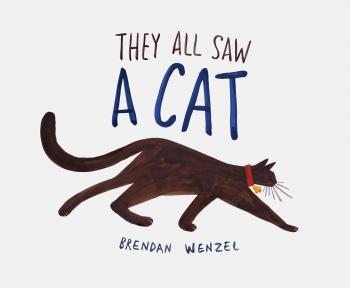
1. This Caldecott Honor book by Brendan Wenzel is deceptively simple in its portrayal of a cat as it "walks through the world." They All Saw a Cat is a visual depiction of the way the cat appears to numerous different animals. When the goldfish sees the cat, it's blurry and bug-eyed as reflected through its tank glass. When the mouse sees a cat, it's a terrifying animals with an emphasis on teeth and claws. For the flea it's a forest of hair, while the bat and the worm "see" it in ways even more unique. This is a lovely introduction to the idea of multiple perspectives.
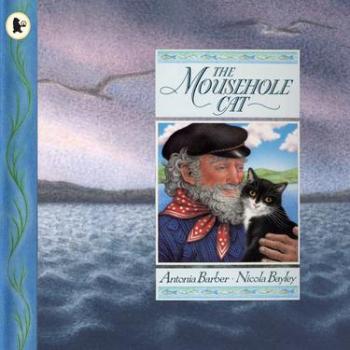
2. The Mousehole Cat (written by Antonia Barber) is a charming story about a brave English cat named Mowzer whose "pet" is a fisherman named Tom. When a long storm rages against their harbor, Mowzer envisions it as The Great Storm-Cat, and decides to see if she can help Tom calm it. This story is probably too wordy for preschoolers -- see my full review here.
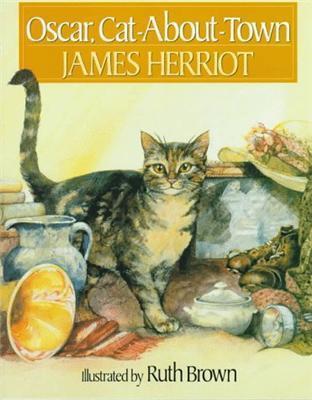
3. English veterinarian James Herriot wrote many wonderful stories for children, brimming with warmth, wonder, and respect for animals' individuality. Oscar, Cat-About-Town is one such story of a unique cat who has a strong desire to always be in the middle of the action, wherever it happens to be occurring! Herriot's stories do tend to have some big words in them, so they may be more appropriate for the older end of the picture book age range. For another Herriot story about a unique cat, see Moses the Kitten, or, if you feel like bawling your eyes out, The Christmas Day Kitten.
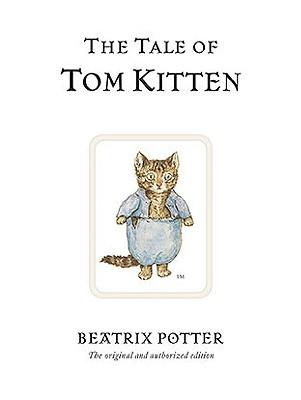
4. The Tale of Tom Kitten is a classic by Beatrix Potter, and tells the story of three kittens whose mother dresses them all up in clothes, sends them outside, and tells them to behave themselves, which works about as well as dressing up kittens would in the real world. Their mother is a cat too, but she acts more like a human, especially in her unrealistic expectations of kittens. It's so delightfully British when she exclaims "I am affronted!" at the end.
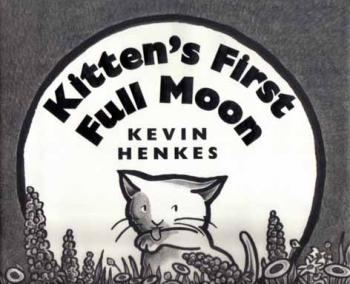
5. The monochromatic illustrations in Kitten's First Full Moon, a Caldecott winner by Kevin Henkes, portray lovely nighttime scenes that illuminate the moon -- which a certain kitten is convinced is actually a big bowl of milk. She spends most of the book trying to figure out how to attain it without success, but manages to have a happy ending anyway. This is a simple, repetitive story that young children would enjoy.
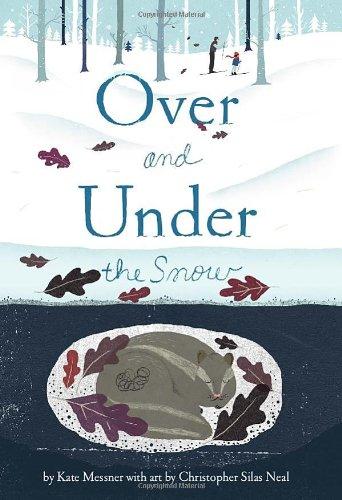
Since we live in a Northern state with long winters and plenty of woods around, Over and Under the Snow is a very relevent book for our climate, but is still an appealing nature book for any child.
The narrative follows a child and parent skiing through the woods, and continually contrasts the visible world that is over the snow with a "hidden kingdom" under the snow, where some animals hibernate, while others eat, sleep, and even make tunnels.
From bull frogs to queen bees, and from deer mice to bears, we are shown a variety of different creatures that spend the winter under the snow, as well as others that spend it above, such as deer and foxes.
One of the best things about this book is the artwork -- lots of earth tones matched with cool wintery blues, which provide a nice contrast to the bright red fox.
At the end the book gives a brief description of each animal mentioned, as well as a list of suggestions for further reading.
Scrounged From: Our local bookstore
Format: Paperback
Author: Kate Messner
Illustrator: Christopher Silas Neal
Pages: 44
Content Advisory: None
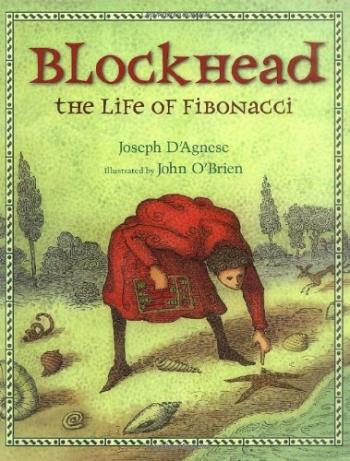
I'll be honest, words tend to hold much more interest for me than numbers. But that means that if I'm going to learn about a new mathematical concept, a picture book like Blockhead: The Life of Fibonacci is probably the best way to do so.
The author, Joseph D'Agnese, admits in the informational page at the end that very little is actually known of Fibonacci's life. So some aspects of this story are speculation, but we are told the basics: that Leonardo Fibonacci was born in Italy in the 1170s and became one of the greatest known Western mathematicians of the Middle Ages.
This book is written from a first-person perspective, and the title is taken from Fibonacci's nickname, "Bigollo," which could mean "traveler," but could also mean "idler, dreamer, or lazy person." In this story, Fibonacci's obsession with numbers leads to him being labeled as a "blockhead" by some, which of course is not true.
As we learn (through dialog with Fibonacci's friend, Alfredo), Fibonacci not only popularized the Hindu-Arabic numeral system that we use today, but he also noticed numerical patterns in the world around him that came up over and over again. This book includes an explanation of his "rabbit problem," (leading to the Fibonacci sequence) and a visualization of the golden ratio spiral. The illustrations include several other examples of the fibonacci sequence in nature, which readers are invited to go back and search for on the last page.
While the book does not really delve into the implications of these numbers, it still gave me a visually engaging way to learn about them, as well as an appreciation for Fibonacci's curiosity, and the incredible complexity of nature. As Fibonacci tells us at the end, "Now you see why I don't mind being called Blockhead, after all!"
Scrounged From: Amazon
Format: Hardcover
Author: Joseph D'Agnese
Illustrator: John O'Brien
Pages: 40
Content Advisory: None (though some may object to use of the phrase "mother nature")
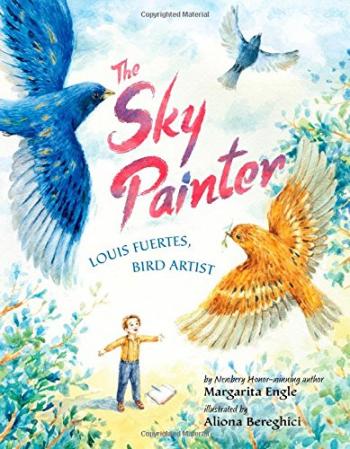
One of my favorite picture books we've read in recent years has to be The Sky Painter. This is the poetically told story of Louis Fuertes, artist and ornithologist, considered to be the successor to John James Audubon.
What this book does so well -- in addition to giving us beautiful, colorful illustrations and educating us about an important but under-appreciated historical figure -- is that it captures Fuertes' sense of awe and wonder at birds -- his respect and curiosity that compelled him in his desire to accurately represent their forms and colors.
Not only did Fuertes desire to learn about and paint birds, but he eventually learned to paint quickly while birds were flying or feeding, in order to keep the "life" in his bird sketches, rather than simply shooting them and posing the dead birds for a portrait as was the custom at that time.
This story, written from a first-person point of view, briefly follows Fuertes' early life and education, as well as his numerous expeditions to distant parts of the world to paint all kinds of different birds. This inspiring combination of art and science helps awaken the reader to beauty while also encouraging curiosity.
The book closes with the information that Furtes' bird paintings were printed on cards that people enjoyed collecting, succinctly expressing Fuertes' legacy in:
"All over the world, millions of people
have learned to enjoy, protect,
and celebrate
the wild beauty
of wings!"
The final page gives a brief biography of Fuertes, and includes two of his actual paintings.
Format: Hardcover
Author: Margarita Engle
Illustrator: Aliona Bereghici
Pages: 40
Content Advisory: None

There are many wonderful picture books that are set in one of the four seasons individually, but here are some of my favorites that encompass all four of the seasons in one book, contrasting their different characteristics and possibilities.
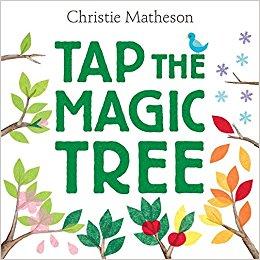
1. Tap the Magic Tree by Christie Matheson is one of my favorites of the "interactive" books we've looked at lately. The illustrations are simple and lovely, and tell the gentle story of the changes an apple tree experiences through all four seasons, though the season names are not explicitly referenced. Children are invited to touch each bud as it blossoms, and blow a gentle breeze over the page to help the colorful leaves fall down. And then at the very end, the cycle starts all over again...
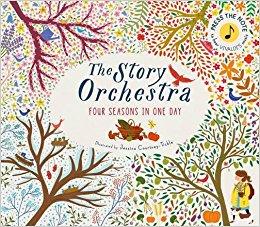
2. Speaking of apple trees, The Story Orchestra: Four Seasons in One Day by Jessica Courtney-Tickle includes a small apple tree carried by a girl named Isabelle, who journeys through all four seasons in one day with her tree and her puppy, Pickle. This is a wonderful book which includes not only beautiful, busy illustrations, but also some musical snippets of Vivaldi's The Four Seasons. This one is a favorite at our house, and you can read my full review here.
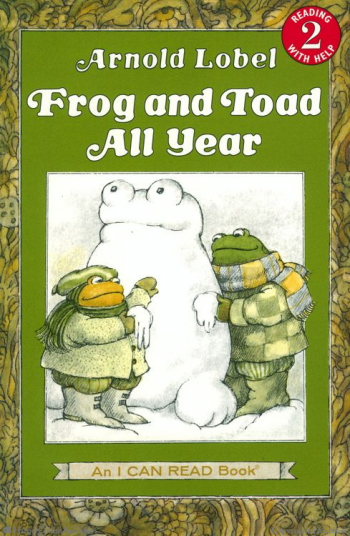
3. Arnold Lobel's Frog and Toad All Year is the third installment in his beloved Frog and Toad series. This volume contains five stories that take place at different times of the year, including a crazy winter sledding adventure, a crazy summer ice cream mishap, and a final Christmas celebration together in front of a warm fire. Although these books are written in an "I can read" style for early readers, they are suitable for any age.
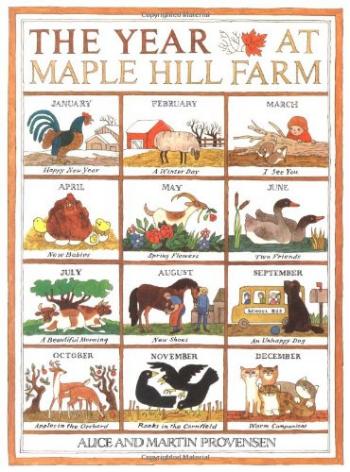
4. The Year at Maple Hill Farm, by Alice and Martin Provensen, is a companion book to Our Animal Friends at Maple Hill Farm. Though this book is less personal in the sense that you don't learn all the names and personalities of the animals, it contains the same warmth and charm of the original, and focuses on the different things that are happening on a farm during each month of the year. From hatching eggs and haircuts to haying, harvest, and worm medicine, this book shows us how the animals experience all the different things each season brings.
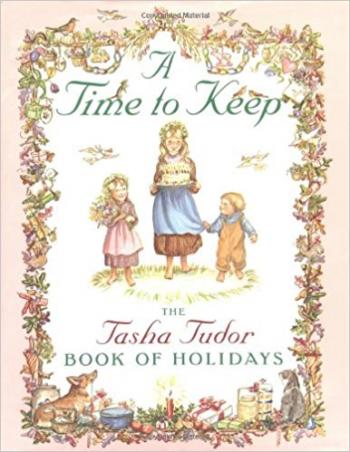
5. Tasha Tudor's lovely artwork makes this book a warm and nostalgic look at special times of the year. A Time to Keep shows us how some holidays were "kept" over the course of a year in this farming community many decades ago. There are some holidays you would expect: Independence Day, Halloween, Christmas, etc., but also some that most of us are unlikely to have celebrated before: Twelfth Night, May Day, St. Nicholas's Birthday, and others. Annual traditions are shown in the framework of seasonal changes, though the focus is on the ways that each particular holiday was made special.
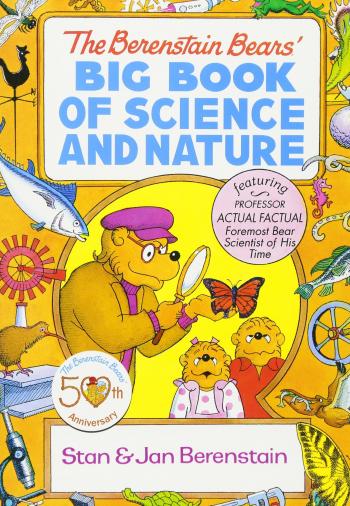
Bonus: For a more scientific look at the different characteristics of each season, The Berenstain Bears' Almanac (one of three books included in The Berenstain Bears' Big Book of Science and Nature) is a great choice. Written in rhyme, this book explores many of the different changes that we and the world around us experience in each season, as well as different holidays and weather phenomena that we encounter over the course of a year.


